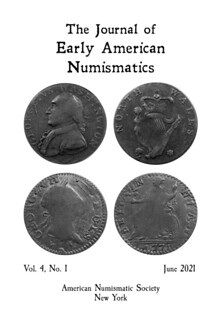
PREV ARTICLE
NEXT ARTICLE
FULL ISSUE
PREV FULL ISSUE
JOURNAL OF EARLY AMERICAN NUMISMATICS JUNE 2021The latest issue of JEAN, the Journal of Early American Numismatics has been published by the American Numismatic Society. Here is the table of contents and an excerpt from the Editor's Preface by Christopher R. McDowell. Thanks. -Editor Editor's Preface
The Coins Made
The Letter from the Officer of the 64th Regiment was not About the
1776 Continental Dollar
The Crane Ring of Rupert, Vermont:
A Family of Counterfeiters at Reuben Harmon's Mint
The Most Persistent Patent Farthing Counterfeiter
Evasion Coppers: A Rose by any other Name
Editor's Preface
I am very proud of the issue you are holding. It has a great mixture of topics from various authors and brings new insight to a host of numismatic subjects. This is the finest and most nuanced issue we have yet produced! My sole compensation as ‘Ye Editor is that I have the joy of reading great articles months before anyone else. This may seem a small benefit compared to the work involved; however, every once in a while an article comes along that makes it all worthwhile. In this issue there is an article by Jérôme Jambu, the former curator in charge of foreign coins, département des Monnaies, Bibliothèque nationale de France. It is, in my humble opinion, one of the finest pieces to ever appear in CNL or JEAN. It blew me away! Jérôme dedicates his article to Sydney Martin. As the article touches on Syd's prior published research and overturns centuries of numismatic conventional wisdom and lore, I immediately sent it to him for his review and opinion. The primary topic of my last conversation with Syd was this article's merits, which we both agreed is an extraordinary achievement. However, like a discussion of the movie The Sixth Sense, it is difficult for me to impart the importance of Monsieur Jambu's monograph to people who have not yet seen it without spoiling the ending. I strongly encourage our subscribers to read this article. There are two articles in this issue penned by my friend Julia Casey—a short piece that touches on the Continental Dollar controversy and another that uncovers a major early American counterfeiting ring. With respect to the more concise article on the Continental Dollar, I previously stated that JEAN would not publish on this topic again unless something new came along. Well, Julia has found something new, something that knocks out one of the major underpinnings of the argument that these pieces were struck in America, and proves the importance of actually reading primary source material as opposed to relying on secondary sources. Julia's second monograph deals with the Crane counterfeit ring that operated, in part, out of Rupert, Vermont, using the same equipment employed to strike many of the Vermont coppers. No one has delved into the coincidental appearance of this major counterfeiting organization in the same small town as the Vermont mint before, and it is about time someone looked into it. This article puts a new spin on the Vermont mint that is sure to have a lasting impact on how that operation is viewed from this day forth. I know that I will never view it the same.
Two of the articles in this issue are long-time labors of love. Jeff Rock and Mark Sportack have
spent their adult lives dedicated to numismatic topics that touch on the American Colonial
experience. First, Jeff Rock presents us with what I call the Mark Sportack ventures into the relatively unexplored area of Patent farthings. Mr. Sportack is to Patent farthings as Mr. Rock is to Evasion coppers, i.e., the undisputed American expert on the topic. Mark has conducted tremendous research on Patent farthings, and his article, like Jeff's, will be the last word for many years to come. Mark helps unlock centuries of mystery surrounding these enigmatic pieces. The depths of his knowledge is expressed by his astounding research and writing ability. Even if you have no current interest in Patent farthings, this article is worth a peek because after you read it, you shall have a new appreciation for them.
For more information on the American Numismatic Society, see:
For more information on the Journal of Early American Numismatics, see:
Wayne Homren, Editor The Numismatic Bibliomania Society is a non-profit organization promoting numismatic literature. See our web site at coinbooks.org. To submit items for publication in The E-Sylum, write to the Editor at this address: whomren@gmail.com To subscribe go to: https://my.binhost.com/lists/listinfo/esylum All Rights Reserved. NBS Home Page Contact the NBS webmaster 
|

